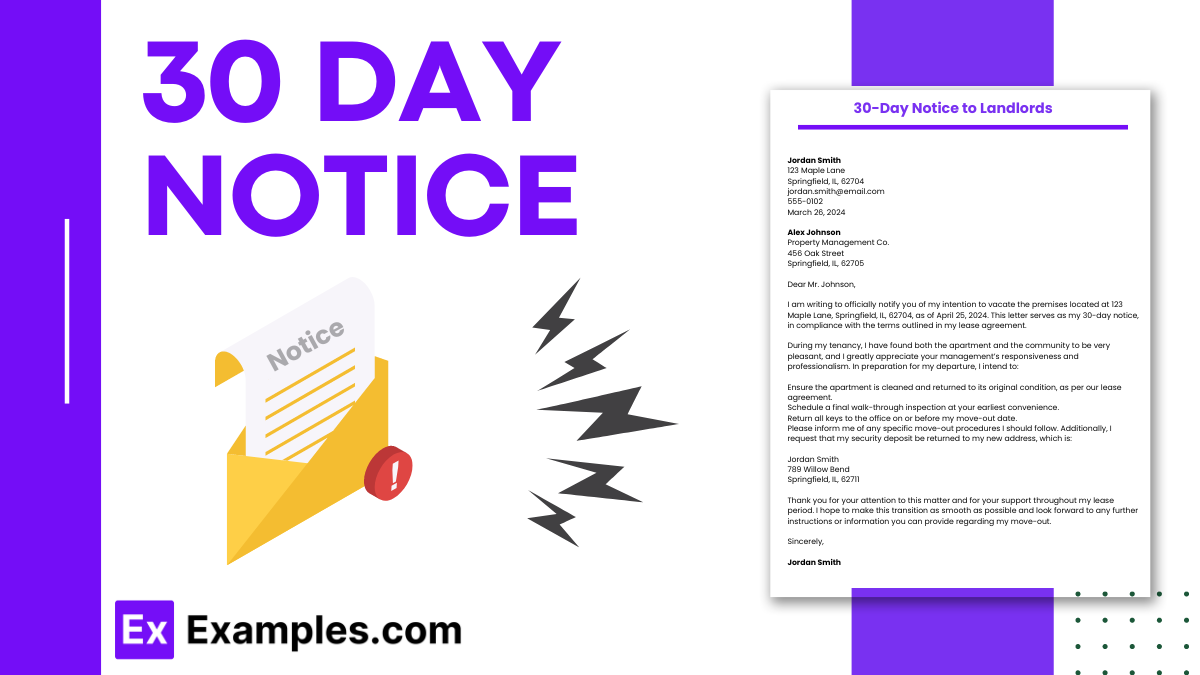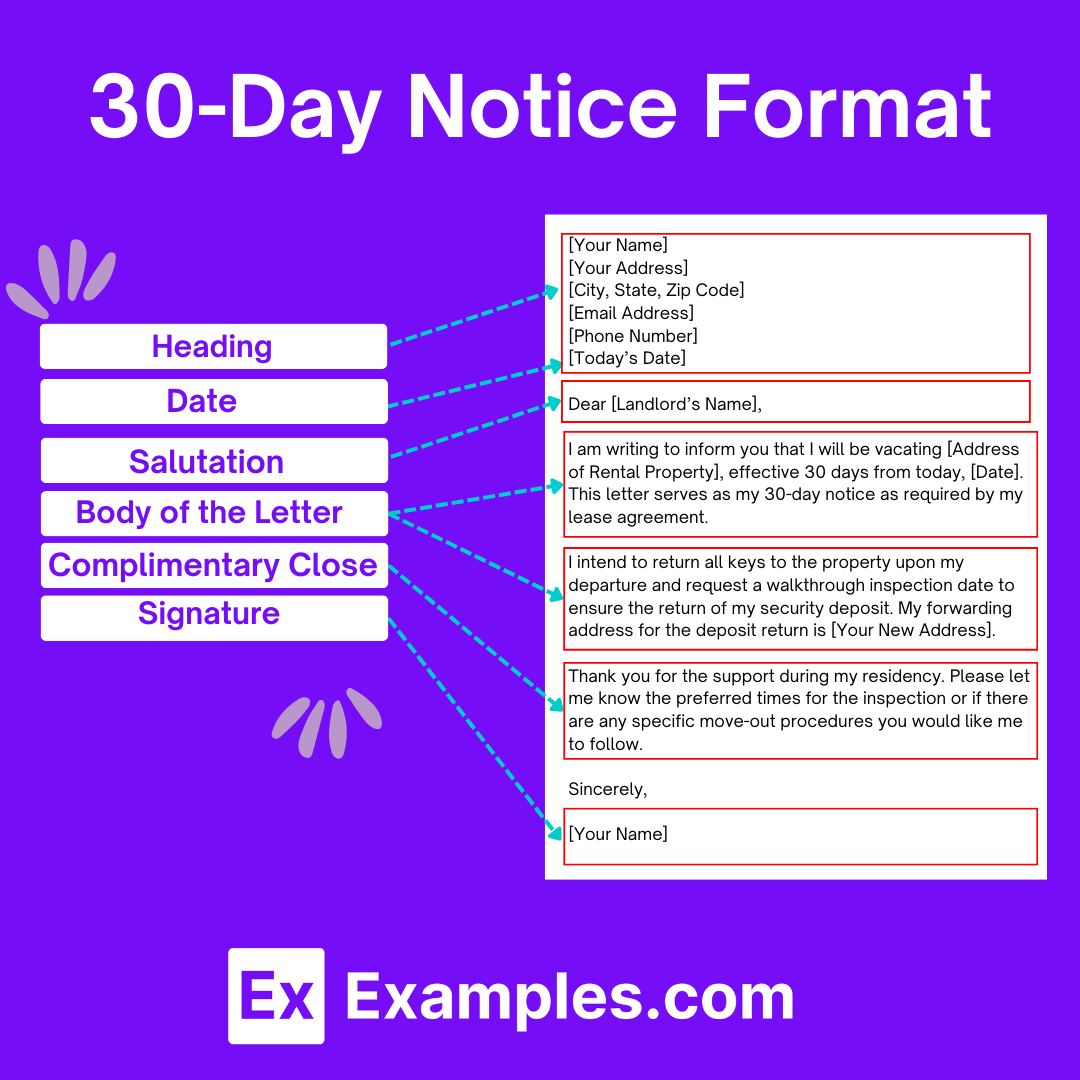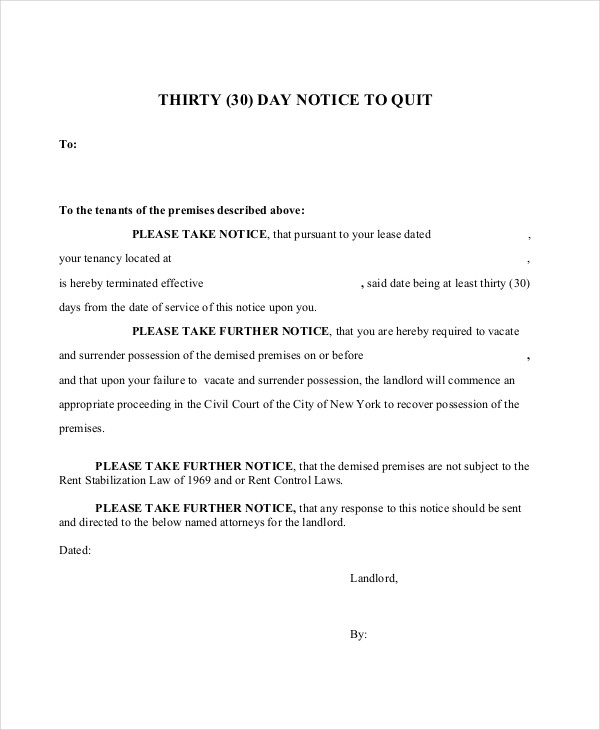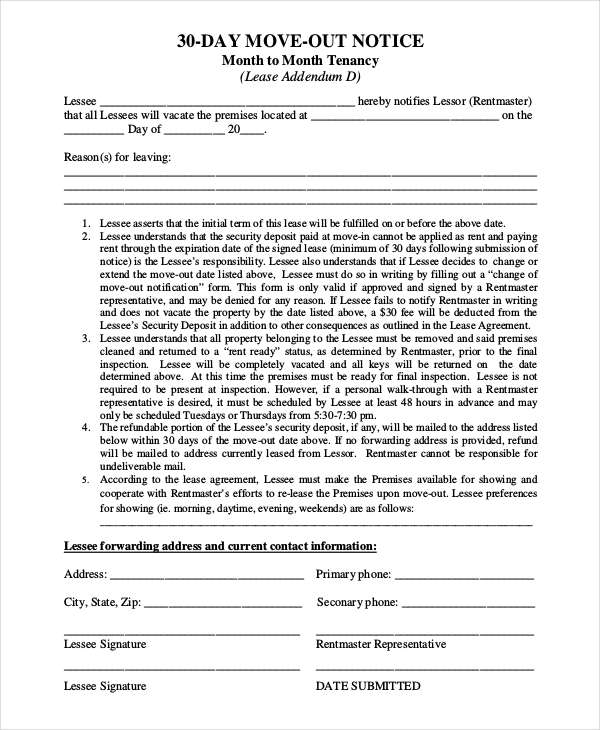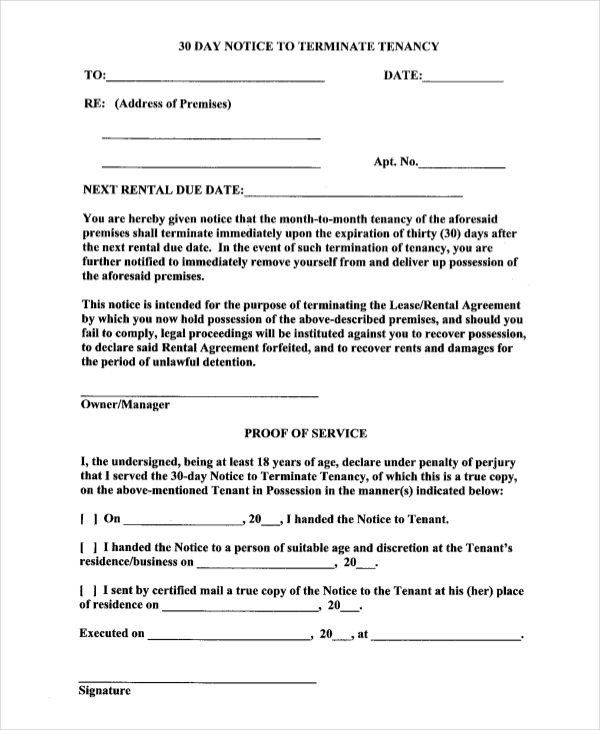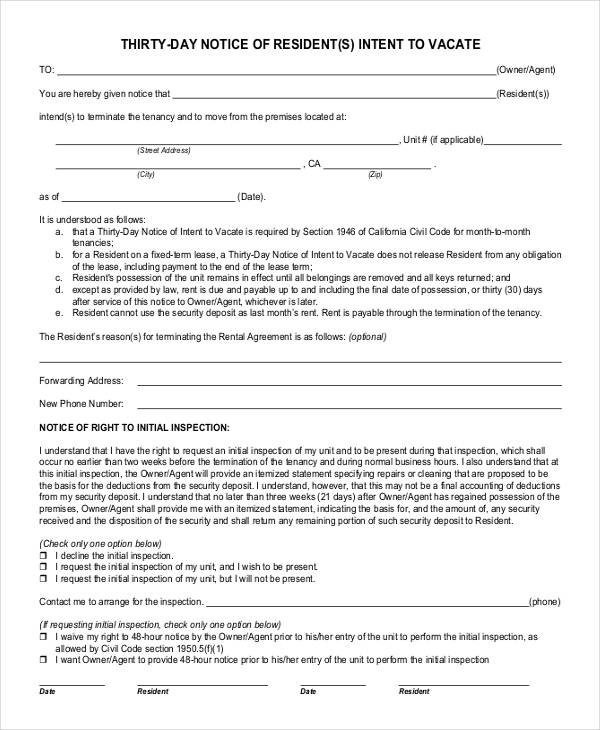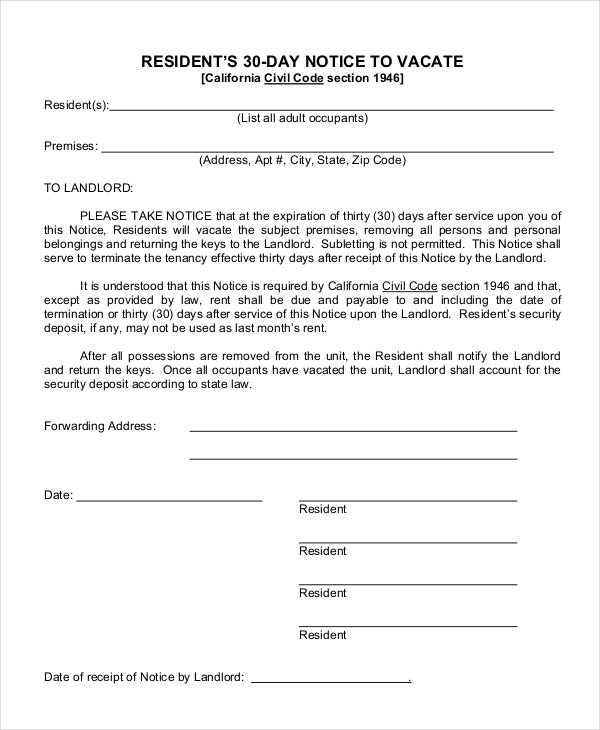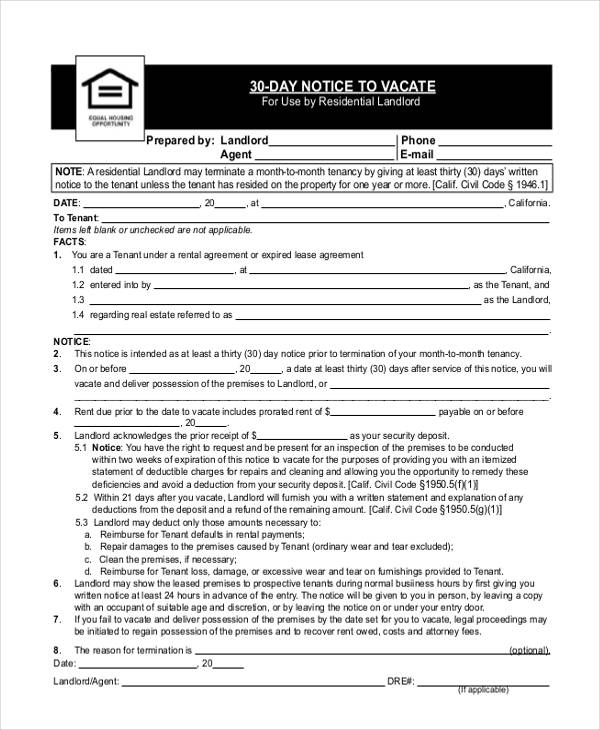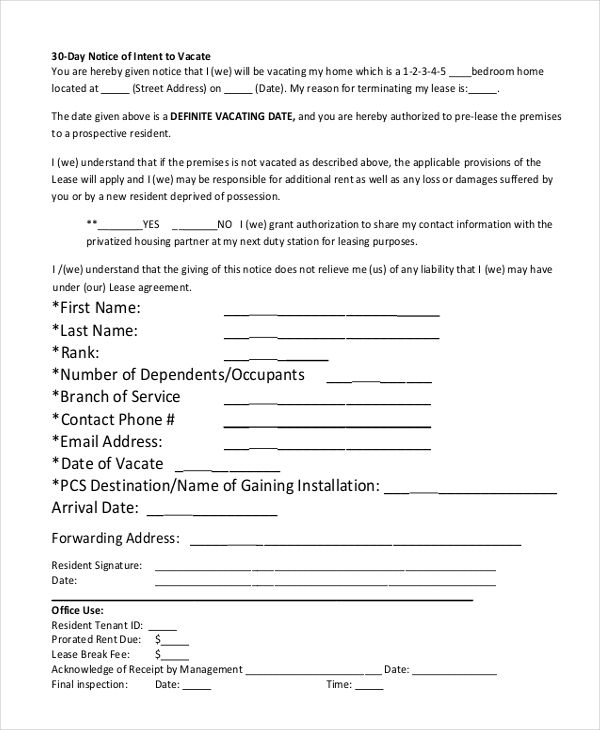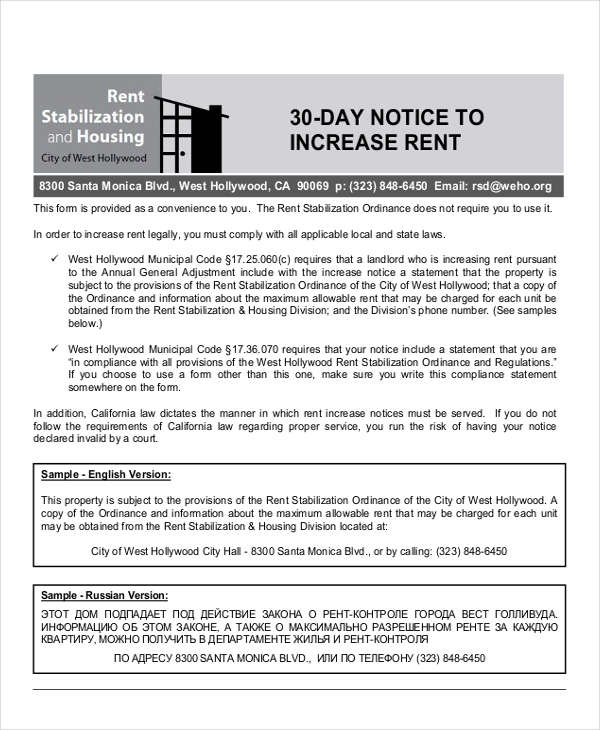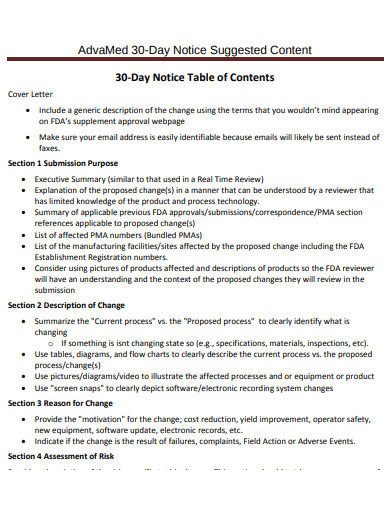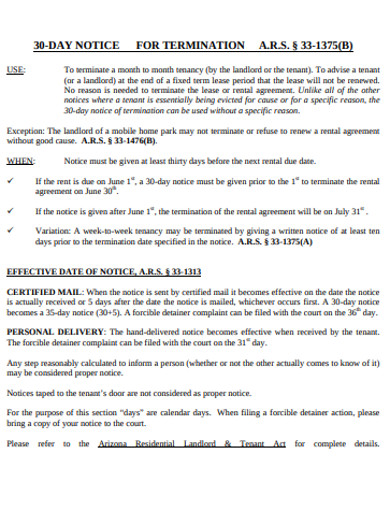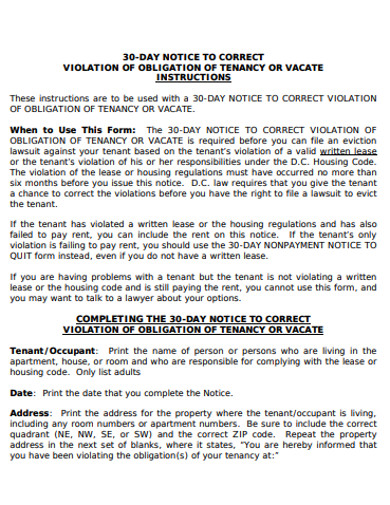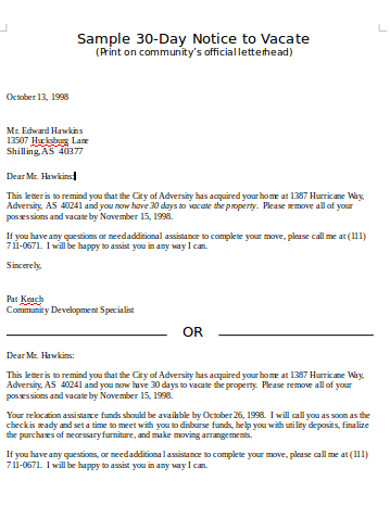15+ 30 Day Notice Examples to Download
Assuming that you are currently renting an apartment, and you simply want to leave. However, similar to how you transferred in that place, it is already a common ethic that leaving should be done properly as well. Hence, inform your landlord using a 30-day notice or with a two-week notice. Regarding how to make one, read through this article to learn more.
There are numerous ways to write a 30-day notice which varies in several aspects. To help you visualize your own composition, why not take a glimpse of these exquisite samples first? If that’s a “why not” from you, here are the best 30-day notices you can relate to.
A 30-day notice to a tenant is an important document but does not equate to an eviction. When a landlord issues this notice, it signifies the end of the tenancy period and the landlord’s decision not to renew the lease. This action does not imply any breach of the lease agreement by the tenant, nor will it appear as an eviction on the tenant’s rental history.
The purpose of the 30-day notice is to provide both the landlord and tenant ample time to prepare for the change. The tenant has the opportunity to find new accommodations, and the landlord can begin the process of finding a new tenant. This notice is a standard legal procedure aimed at ensuring a smooth transition without any penalties or negative impacts on the tenant’s future rental opportunities.
30-Day Notice Format
[Your Name]
[Your Address]
[City, State, Zip Code]
[Email Address]
[Phone Number]
[Today’s Date]Dear [Landlord’s Name],
I am writing to inform you that I will be vacating [Address of Rental Property], effective 30 days from today, [Date]. This letter serves as my 30-day notice as required by my lease agreement.
I intend to return all keys to the property upon my departure and request a walkthrough inspection date to ensure the return of my security deposit. My forwarding address for the deposit return is [Your New Address].
Thank you for the support during my residency. Please let me know the preferred times for the inspection or if there are any specific move-out procedures you would like me to follow.
Sincerely,
[Your Name]
How to Write a 30-Day Notice
Writing a 30-day notice is a formal way of informing your landlord or employer that you plan to vacate a property or resign from a position. Here’s a structured approach to crafting a clear and professional 30-day notice:
Heading
Start with your name, address, today’s date, and contact information at the top of the page.
Salutation
Address the recipient properly, such as “Dear [Landlord’s Name]” or “Dear [Employer’s Name],”.
Introduction
Clearly state your intention to vacate the property or resign from your position, including the effective date which should be 30 days from the date of the letter.
Example for a Rental:
“I am writing to inform you that I will be vacating my apartment located at [Apartment Address] as of [Date 30 days from the letter’s date].”
Example for Employment:
“I am writing to formally resign from my position at [Company Name], effective [Date 30 days from the letter’s date].”
Body
- For a Rental: Briefly mention your reason for leaving, if you wish, and outline any relevant details such as your plan to return keys and your forwarding address for the security deposit.
- For Employment: Express gratitude for the opportunity and experiences gained. Offer to assist in the transition, whether through training a replacement or completing projects.
Closing
Thank them for the opportunity, understanding, or cooperation during your time with the property or company. State your hope for a smooth transition.
Signature
Close with “Sincerely,” or “Best regards,” followed by your name. If you’re submitting a printed letter, leave space for your handwritten signature above your typed name.
How much notice do I need to provide before moving out?
The amount of notice you need to provide before moving out typically depends on the terms of your lease agreement or local laws governing tenancy. In many places, a standard requirement is a 30-day notice for month-to-month rental agreements. However, this can vary, especially for fixed-term leases, where the notice period might be different or specified in the lease itself. Always review your lease agreement and consult local tenant-landlord laws to determine the exact notice period required in your situation. It’s crucial to provide this notice in writing and within the proper timeframe to avoid penalties or legal issues.
How To Send Your Landlord A 30 Day Notice?
Sending your landlord a 30-day notice is a crucial step in the move-out process, ensuring you comply with rental agreement terms and maintain a good relationship with your landlord. Here’s a step-by-step guide on how to properly send a 30-day notice:
Step 1: Review Your Rental Agreement
- Check Terms: Look for any specific requirements about how and when to send a move-out notice. This ensures your notice is compliant with the lease terms.
Step 2: Write the Notice
- Be Clear and Concise: State your intention to vacate the property, providing the exact date you plan to leave, which should be at least 30 days from the date of the notice.
- Include Essential Details: Your notice should include your current address, the date, your planned move-out date, and any other details required by your lease, such as your forwarding address for the security deposit return.
Step 3: Format the Notice Properly
- Professional Tone: Use a respectful and professional tone throughout the letter.
- Proofread: Ensure there are no errors or typos to maintain professionalism.
Step 4: Deliver the Notice
- Follow Lease Instructions: Deliver the notice according to the method outlined in your lease (e.g., email, certified mail, hand delivery).
- Keep Records: Always keep a copy of the notice for your records. If sending by mail, consider using certified mail to have proof of delivery.
Step 5: Follow Up
- Confirm Receipt: If you don’t receive an acknowledgment, follow up with your landlord to ensure they received your notice.
How do I inform my landlord I am intending to move out?
1. Review Your Lease
- Check your lease agreement for specific terms regarding notice requirements and procedures for moving out. This will often dictate how much notice you need to give (typically 30 days).
2. Write a Notice Letter
- Compose a formal notice letter stating your intention to move out. Include your move-out date, which should comply with the notice period specified in your lease.
Notice Letter Structure:
- Your Contact Information: Include your current address, phone number, and email.
- Date: The date you are writing the letter.
- Landlord’s Contact Information: Address the letter to your landlord or the management company’s name and address.
- Statement of Intent: Clearly state that you are providing notice to vacate the rental property. Include the specific date you intend to move out.
- Lease Information: Mention any relevant lease agreement terms, especially those related to the notice period and your compliance with them.
- Property Condition: Indicate your intention to leave the property in good condition, adhering to the terms of your lease.
- Request for Walk-Through: Optional, but you may request a final walk-through with the landlord to ensure any potential issues are addressed.
- Forwarding Address: Provide your new address for the return of the security deposit.
- Closing: Thank your landlord for the rental opportunity and express hope for a smooth move-out process.
- Signature: Sign the letter if sending it by mail or in person.
3. Deliver the Notice
- Deliver your notice letter to your landlord. Follow any specified methods outlined in your lease, such as hand delivery, certified mail, or email. Keep a copy of the letter and any delivery receipts for your records.
4. Prepare for Move-Out
- Begin preparing for your move by organizing, packing, and cleaning the rental property to ensure you leave it in good condition.
5. Schedule a Final Walk-Through
- If possible, arrange a final walk-through with your landlord. This allows both parties to assess the property’s condition, discuss any damages, and agree on the return of the security deposit.
15+ Notice Examples
30-Day Notice to Landlord
30-Day Notice to Quit
30-Days Notice to Vacate
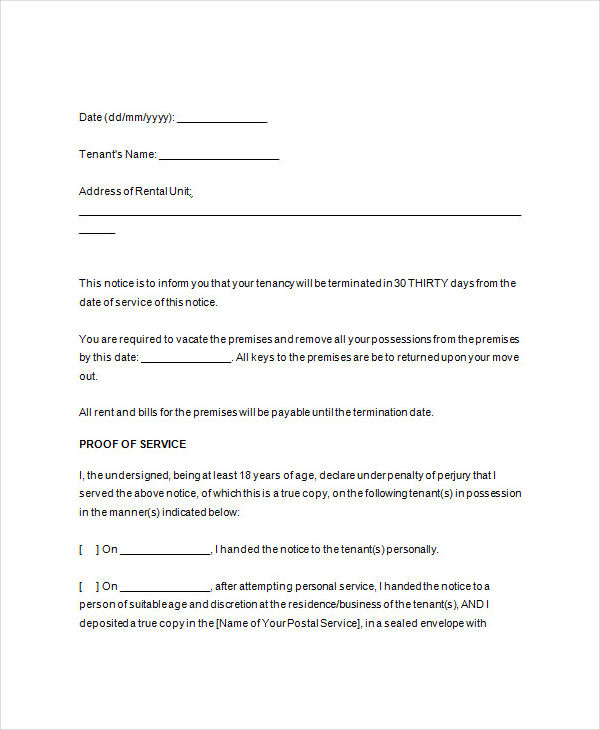
30-Day Move Out Notice
Tenant 30-Day Notice
30-Day Eviction Notice
Resident’s 30-Day Notice to Vacate
Printable 30-Day Notice
30-Day Notice of Intent to Vacate
30-Day Notice to Increase Rent
30-Day Notice Table of Content
30-Day Notice for Termination
30-Day Notice Example
Sample 30-Day Notice to Vacate
30-Day Notice of Intent Vacate
30 Day Notice to Move Out
[Your Full Name]
[Your Address]
[City, State, Zip Code]
[Your Phone Number]
[Your Email Address]
[Today’s Date]
[Landlord’s/Property Manager’s Name]
[Landlord’s/Property Manager’s Company Name]
[Landlord’s/Property Manager’s Address]
[City, State, Zip Code]
Dear [Landlord’s/Property Manager’s Name],
I am writing to formally notify you of my intention to vacate the rental property located at [Rental Property Address] on [Vacating Date]. Per the terms of our rental agreement, this letter serves as the required 30-day notice prior to my departure.
I will ensure that the property is returned in good condition, and I am willing to schedule a final walkthrough inspection at your earliest convenience. Additionally, please advise on the preferred method for returning the keys and settling any outstanding matters related to my tenancy.
As stipulated in our agreement, I expect the return of my security deposit within [Number] days following the conclusion of my tenancy. Kindly arrange for this to be sent to my new address, which is as follows:
[Your New Address]
[City, State, Zip Code]
Should you require any further information or clarification, please do not hesitate to contact me via phone at [Your Phone Number] or via email at [Your Email Address].
Thank you for your attention to this matter. I appreciate your cooperation and understanding during this transition period.
Warm regards,
[Your Full Name]
[Your Signature]
Steps to Giving Your 30 Days Notice to Landlord
Giving a 30-day notice to your landlord is a crucial step in terminating your rental agreement responsibly. Here are the steps to ensure you handle the process correctly and maintain a positive relationship with your landlord.
Step 1: Review Your Lease Agreement
- Understand Terms: Check your lease for specific terms about ending your tenancy, including notice period requirements and how the notice should be delivered.
Step 2: Write Your 30-Day Notice
- Include Essential Information: Your notice should clearly state your intention to leave, the date you will vacate the property, and your forwarding address. Be concise yet thorough.
Step 3: Format the Notice Professionally
- Professional Tone: Use a respectful and professional tone in your notice.
- Proofread: Ensure the notice is free from errors.
Step 4: Deliver the Notice Appropriately
- Follow Lease Instructions: Deliver your notice in the manner specified in your lease, whether that be via email, hand delivery, or certified mail.
- Keep Records: Retain a copy of the notice and any correspondence or receipts related to its delivery.
Step 5: Prepare for Move-Out
- Clean and Repair: Plan to clean the property and make any necessary repairs to ensure you leave the property in good condition.
- Schedule a Walk-Through: If possible, schedule a final walk-through with your landlord to discuss any potential issues or concerns.
Step 6: Return Keys and Property Items
- Coordinate Key Return: Arrange to return all keys, fobs, or other property-related items to your landlord on or before your move-out date.
Step 7: Follow Up on Security Deposit
- Security Deposit: Ensure you provide a forwarding address for the security deposit return and inquire about the timeline for receiving it.
Step 8: Keep Communication Open
- Stay in Touch: Keep lines of communication open with your landlord throughout the move-out process to address any last-minute details or questions.
What Should a 30-Days Notice Say?
If you are a tenant and decided to move out, then you are obliged to give your landlord a 30-day notice. Inform your landlord by providing a 30-day notice so that everything will work well to both you and to your landlord.
Your 30-day notice should include your reasons as to why you are vacating the place and the date of your departure. Keep in mind that it should be within 30 days from the date you are giving the notice. Include a forwarding address so that if you have deposits, they know where to send it.
Still having trouble as to what you are going to say in your 30-day notice? Just download our 30-day notice examples in word, pdf and Excel format.
Writing a 30-Day Notice To a Landlord
Moving out from a lease is as quite daunting as finding a new place to stay, but it can all be seamless using the 30-day notice. You can also use this if you wish to give the landlord a notice to vacate.
- Write it as a formal letter. Start with the date, the landlord’s name, and his/her complete mailing address.
- Greet the landlord properly using a salutation, such as “Dear (landlord’s name)”.
- State your reasons to move out. Keep it concise but informative.
- Enclose in an envelope. You can give it personally or you can use a mail.
FAQs
What Do You Say When You Give 30 Days Notice?
When giving a 30 days notice, clearly state your intention to vacate the property or resign from your position, specifying the effective move-out or resignation date. Include a brief thank you for the opportunity and any details required by your agreement.
How Many Days Is a Month’s Notice Period?
A month’s notice period typically requires you to give notice 30 days before vacating a property or resigning from a job. This standard can vary based on local laws or specific agreements, so it’s essential to check your contract or lease.
How Do You Write a Notice That You Are Moving Out?
To write a notice that you are moving out, include your name, address, the date, your landlord’s contact information, a statement of your intent to vacate with the effective date, and your signature. Optionally, mention your new address for the deposit return.
What Is a Notice to Quit Letter from a Landlord?
A notice to quit letter from a landlord is a formal document informing a tenant to vacate the property by a specified date. This can be due to lease violations, the end of the lease term, or other legal reasons requiring tenancy termination.
How Do I Write a Quit Notice to a Tenant?
To write a quit notice to a tenant, state your name and contact information, the tenant’s name and rental address, the reason for the notice, the date by which the tenant must vacate, and any legal references supporting the notice. End with your signature and date.


